Army Art Posters and Prints
World War II: The Final Stages
CMH Pub 70-48;
GPO S/N: 008-020-00254-0
10 full-color 11" X 15 1/2" reproductions of paintings by Army Artists of World War II. Each of the prints includes the name of the work, the general location it depicts, and the name of the artist. The extended caption on each print provides background information on the subject matter illustrated. The artists whose work is represented here actually witnessed the scenes they portrayed, and in some cases the words in the caption are those of the creator of the artwork. In others the caption simply helps put the scene in context. This print set was designed and produced by the U.S. Army Center of Military History to commemorate the fiftieth anniversary of World War II. The pictures and words are in remembrance of the sacrifices and accomplishments of all the men and women who served in World War II. Individual prints may not be requested.
* View this publication online.
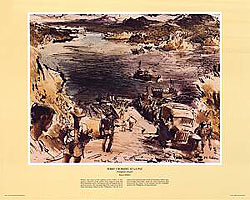
FERRY CROSSING AT LA PAZ - Philippine Islands
by Barse Miller
Within four days of the capture of the Straits of San Juanico, elements of the Army's 592d Engineer Boat and Shore Regiment of the 2d Engineer Special Brigade had set up ferry service. The crossing linked the road networks of Leyte and Samar Islands in the Philippines. The site is located some fourteen miles north of Tacloban, where General Douglas MacArthur made the radio broadcast that announced his return to the islands and the establishment of the Philippine civil government.
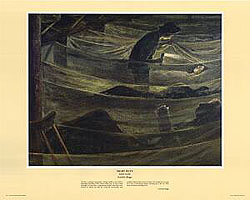
NIGHT DUTY - South Pacific
by Franklin Boggs
"It was a strange experience, being inside a net with a flashlight shining on the scenes about you. A nurse came through to look after a shipwrecked sailor who had swallowed so much oil that he vomited constantly and couldn't keep down food or water. You would see an arm in a cast, or bandaged limbs, sticking up in the air. Men were restlessly turning over."
- Franklin Boggs
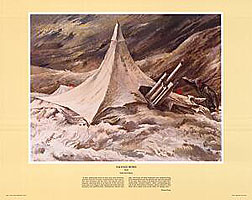
SALVAGE ROSES - Italy
by Edward Reep
"At first, artillerymen lived in tents near their howitzers, and then because of heavy counter-battery, they dug in. The rains increased and the tents were placed over the weapons, allowing them to be fired out of the tent door. Soon after, snow began to fall regularly and both tents and howitzers were painted white. Ammunition, kitchen supplies, and nearly all other equipment was marked by long poles being driven into the ground with red cans attached to the tops. After weeks of snowfall the white valley blossomed forth. General Charles L. Bolte, commanding general of the 34th Infantry Division, always referred to this Indice River valley scene as the valley of 'salvage roses.'"
- Edward Reep

U.S. ARMY ENGINEER BASE YARD - Saipan
by Hans Mangelsdorf
As Allied forces moved across the Pacific, they had to develop supply bases and airfields on conquered islands in order to advance to the next island. Even before Saipan had been completely cleared of enemy forces, Army engineers began the job of transforming it into the most powerful base in the Pacific. American forces landed on the island in June 1944, and by November B-29 Superfortresses were flying bombing missions from the runways the engineers had cleared from the hard coral rock.

SKIDLOADS AND CONVEYORS - France
by David Lax
"When an enemy port fell nearly intact, every T.C. [Transportation Corps] shortcut came into play. Big crates were skidded behind tractors; boxes were rolled over conveyors. Everything was unloaded with planned hurry, for all ships were 'pre-stowed' to accelerate discharge, and every item was code-marked for delivery to Ordnance, Signal, QM [Quartermaster], or other army organizations."
- David Lax
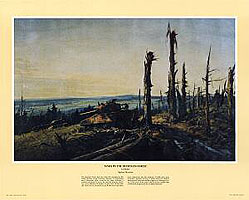
TANKS IN THE HUERTGEN FOREST - Germany
by Ogden Pleissner
The Huertgen Forest was one of the first obstacles to the Allied advance inside Germany. Between 14 September and 9 December 1944, a total of five Army divisions, a combat command of armor, an armored infantry battalion, and a battalion of Rangers fought there. By the time the forest was in American hands 8,000 men had fallen from exhaustion and the elements; 23,000 more were wounded, captured, missing, or killed. When the artillery shelling from both sides finally stopped, the Huertgen Forest, in the words of the Army's official history, looked "like a battlefield designed by the Archfiend himself."

TRAIN CROSSING THE MOSELLE - France
by A. Brockie Stevenson
In June 1944 advance elements of the Military Railway Service (MRS), part of the Army�s Transportation Corps, landed at Omaha Beach to survey the rail situation. During the advance across Europe Army engineers repaired damaged bridges and track, and the MRS operated the rail system until it could be turned over to civilian authorities. By the end of 1944 more than half of all Allied tonnage required to support the fighting forces in northern France moved by rail from the rear areas.

ALL ABOARD FOR HOME - England
by Joseph Hirsch
By the end of hostilities the Army had twenty-six hospital ships in service with accommodations for a total of 16,755 patients. The largest and fastest of these, the Frances Y. Slanger (the converted Italian cruise ship Saturnia), could handle more than 1,500 patients. As with other Army-operated vessels in World War II these floating hospitals carried civilian crews in the deck, engine, and stewards departments, but military personnel provided medical care to the patients.
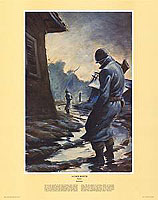
A COLD WATCH - France
by Kutchko
The last few months of the war in Europe were cold and wet. As the Allied advance liberated occupied territory, rear-area facilities had to be guarded against theft and sabotage. For soldiers who drew guard duty the weather was a much more serious and real enemy than the German Army. The discomfort of standing watch in miserable weather shows clearly in this scene, which was probably inspired by the personal experience of the soldier-artist who painted it. Unfortunately, little else is known about the artist, who signed his paintings simply "Kutchko".
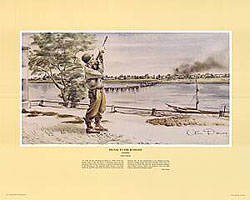
SIGNAL TO THE RUSSIANS - Germany
by Olin Dows
"At 1145 on the morning of April 25, 1945, from the Strehla bank of the Elbe River, Lt Kotzebue fires two red and green flares from a carbine as a signal of identification to the Russians on the opposite bank. Below is the boat which he and five men from his patrol used to reach the Russian side. In the background is the drifting German pontoon bridge which has been knocked away from its moorings by shell fire and the mixed German military and civilian convoy which was trying to cross the Elbe when destroyed by Russian tanks."
- Olin Dows